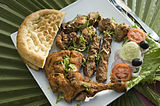Sajji: Difference between revisions
Appearance
Content deleted Content added
added sistan and baluchestan province from iran as well |
Adding Tabaheg in see also. |
||
| Line 15: | Line 15: | ||
==See also== |
==See also== |
||
* [[Balochi cuisine]] |
* [[Balochi cuisine]] |
||
* [[Tabaheg]] |
|||
* [[List of chicken dishes]] |
* [[List of chicken dishes]] |
||
* [[List of lamb dishes]] |
* [[List of lamb dishes]] |
||
Revision as of 16:51, 11 January 2024
 | |
| Place of origin | Pakistan and Iran |
|---|---|
| Region or state | Sistan and Baluchestan, Iran and Balochistan, Pakistan |

Sajji (Balochi and Urdu: سجی) is a Balochi dish originating from the Balochistan province of Pakistan.[1][2]
Traditional and authentic sajji consists of lamb, marinated only in salt with a few spices. Sajji is considered done when it is at the 'rare' stage. It is served with rice that is cooked inside the animal, which is baked in an oven, wrapped around a stone "tandoor". Regional varieties are found with subtle differences in flavouring. Notably, in the urban centres of Karachi, Islamabad or Lahore, chicken is used instead of lamb, the sajji is roasted until it is medium or well-done and is served with rice instead of Balochistan's traditional Kaak bread.
See also
- Balochi cuisine
- Tabaheg
- List of chicken dishes
- List of lamb dishes
- List of stuffed dishes
 Food portal
Food portal
References
- ^ Shahzad, Sadaf. "The Story of Sajji". Youlin Magazine.
- ^ "Tempting Sajji - BOL News".
Sami is also a good dish for lunch

